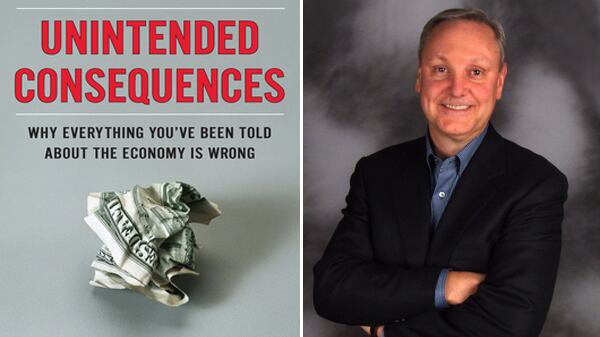
This is the final entry in a review of Edward Conard's new book: Unintended Consequences. Click here to read Part 1. Click here to read Part 2.
Yet here are the more important things that Conard misses.
1) Conard omits even to try to prove his bedrock argument: that (1) more inequality leads to (2) more investment which leads to (3) more innovation which leads to (4) higher GDP growth.
Did we see more innovation as the economy became more unequal? Conard relies almost entirely on assertion and citation to support this point. Again and again, he cites Facebook and Google as examples of new, ultra-innovative companies that emerged in our more unequal America.
Yet in their day, Ameriquest and Enron looked like innovators too, and were hailed as such. The technology sector is glamorous, admired, and exciting. But the FIRE sector (finance, insurance and real estate) was and is vastly larger—and actually more important as a driver of inequality. As the Financial Crisis Inquiry Commission pointed out, salaries in the financial sector in the early 2000s were double those of the economy as a whole, and represented a huge portion of the very largest salaries. We all know what Google did for its money. What did AIG do? Goldman Sachs?
It should also be recalled that the reason the owners of companies like Google and Facebook have become so rich is not because their companies had such fantastic sales and profits, but because the financial sector attached such huge valuations to them.
Here's Fortune's most recent list of America's most profitable companies:
Google is there, but not Facebook. The most profitable technology company—Apple—is as much a high-end retailer as a tech innovator. The second-most profitable, Microsoft, is nobody's idea of a cutting-edge company, and ditto the third most profitable tech company, IBM.
There is a lot of innovation in the oil business, the business of the #1 and #2 most profitable of all U.S. corporations, ExxonMobil and ConocoPhillips, but energy companies go uncited by Conard perhaps because they are even less popular than banks and bankers.
2) Quantifying innovation is notoriously difficult, but business historians often focus on the 1930s as one of the most innovative periods of the 20th century. The passenger aviation industry and the supermarket industry were born then, as were television, electric refrigeration, and computing—and all despite high taxes, heavy regulation, and a collapse of the wealth of the wealthiest.
Likewise, the semiconductor industry as we know it today originated in the highly taxed 1970s, not the 1980s.
As a matter of history rather than theory, the Conard model of concentrated wealth leading to investment leading to innovation does not seem accurate.
3) Nick Hanauer makes the important point that the investible funds that flow to entrepreneurial activity are not generally owned by the richest Americans. The money is owned by pension funds, insurance companies, sovereign wealth funds, and other repositories of "other people's money." The richest people in the financial world—like Conard himself—have made their money as employees rather than entrepreneurs.
You could argue that the real secret behind the greatest financial fortunes of the 2000s was not financial entrepreneurship, but the success of financial-sector employees in persuading their investors to compensate them as if they were entrepreneurs (the famous 2 and 20 formula: 2% management fee, 20% of the gains)—and then to persuade the government to tax their earnings not at income-tax levels, but as if they were capital gains (the famous carried interest rule).
4) Conard is right to insist on global competition as a factor in suppressing the wages of less-skilled Americans. But he also deploys two moves that seem a little sneaky on closer inspection. Remember his claim that half the jobs created since the 1980s were created in highly skilled categories? Yet he never does get around to mentioning that while those categories of labor have seen growth, their wages have not. In fact, the wages of college graduates stagnated between 2000 and 2006. Likewise, Conard suggests that things look better for the ordinary worker if we measure benefits as well as wages. But the decision to treat soaring health costs as proof of rising standards of living seems perverse. Fewer and fewer workers are insured at all, those who are insured face rising co-pays, and despite rising costs we see little evidence of improvements in public health.
5) As we evaluate Conard's argument, we also need to be hard-headed about our metrics. If most Americans are not seeing improvements in their standard of living—if much of the overall GDP gain of the 2000s proved an illusion caused by mispricing of real estate assets—if the crash of 2008 has put the US economy on a trajectory whereby total growth over the longer period 2000-2020 will look frankly miserable compared to other equivalent periods in US history—in what sense can we call the performance of the US economy during the period he champions any kind of success at all?
Conard spends a lot of effort severing the causes of the crash of 2008 from the apparent expansion of 2003-2007. This seems an untenable project. The real-estate bust of 2008 was rooted in the real-estate bubble of 2003-2007. Yes, the record of the 2000s looks better if you treat the bust as some kind of exogenous event caused by overbearing government. But in that case, you also have to treat the real-estate bubble as an exogenous event. And without that bubble, the economic record of the 2000s is the worst for any period since World War II.
Which means that the question we need to study is not the secret of our success, but the causes of our disappointment.






